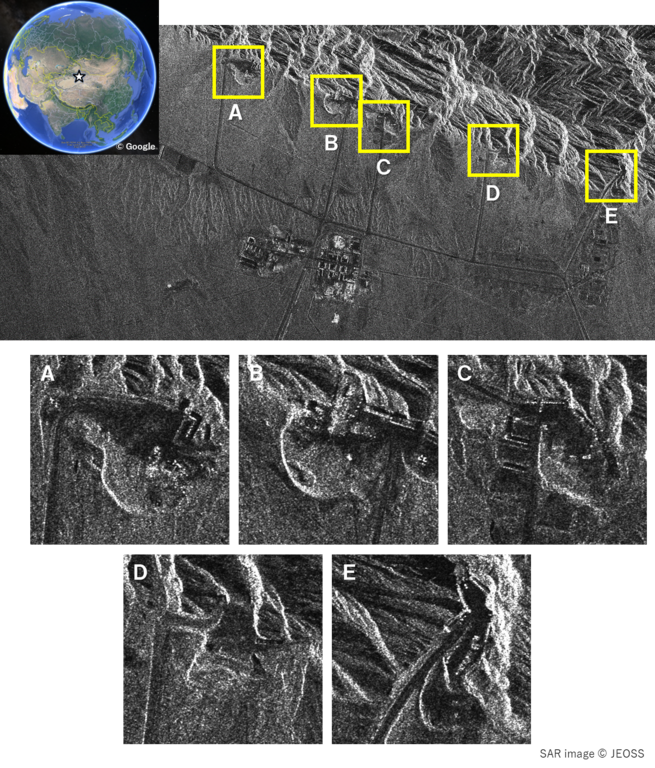China conducts 46 nuclear tests at the Lop Nur nuclear test site, located in Xinjiang Uygur Autonomous Region, by July 1996 after China’s first nuclear test (atmospheric test) was conducted in October 1964. China has not signed the 1963 Partial Test Ban Treaty (PTBT), which bans atmospheric nuclear testing, but since 1992 it has moved to underground nuclear testing, and five tunnels have been developed since then.
In 2017, a satellite imagery captured China's activity of building and renovating facilities at the Lop Nur nuclear test site, and by 2021 at the latest, optical satellite imageries had confirmed that there are new horizontal tunnels being dug for underground nuclear testing.
In this project, I found various possible construction activities in the area with multiple vertical tunnels, by using SATSAR (synthetic aperture radar) imageries.
In 2022, the tunnels in the images A, B, and E were analysed as being in an operational state. When looking at the current SAR images, you can see that in images A and B, the borders of the dirt mound are strongly reflective (the edges are sharp). It means that they are neatly maintained and prepared. Compared to these, the dirt mounds found on images C and D have some crumbling in their outer edges.
Besides this, the tunnel entrance and the foundation of the structures in image A looks like being shaped by materials such as concrete and preserved in that state. Another point worth noting is how, in image B, there are strong echoes presumed to be either a vehicle or a container, which is in a different location than when its image had been taken in April. These features suggest that some kind of activity is continuing in the tunnels shown on images A and B.
Looking at what is said to be the fifth tunnel in image E, it seems to be that the open space in front of the tunnel and the road leading to the tunnel show low reflectance (it looks a deeper black colour), compared to both image A and B, meaning that there is a high possibility that it is either paved or cast with concrete. This being paved implies that there is a high frequency of heavy vehicle traffic.
Another point concerning image E, two rectangular-shaped strong echoes, each measuring approximately 3 metres on each side, are captures on the north-west side of the open space in front of the tunnel. Depending on when the image was taken, the number of these echoes vary, and there is the possibility that the accumulation of the materials which will be used in the tunnel. An optical satellite image taken in December 2023 shows the tracks of a vehicle which moved on the open space in front of the tunnel. A slightly dim line shape echo extending from the exit of the tunnel is also present, which may be a cable-like object leading inside.
The above-mentioned signs of continued work indicate a possible resumption of nuclear testing by China. China’s most recent ICBM, the DF-41, has been MIRV-ed (it is capable to deliver multiple nuclear warheads to different targets), and is said to be capable of carrying up to 10 warheads, but some sources say that the warheads have not been sufficiently miniaturised, and that in actuality it can only carry around three warheads. Given this situation, it is inferred that there is a high possibility that China will conduct nuclear tests in order to downsize nuclear warheads. Whether these tests will be ones with explosions, or subcritical experiments that do not involve explosions is still debated. It is believed that China will at least conduct a subcritical experiment in order to improve the performance of, and maintain the quality of, its nuclear warheads. Subcritical experiments are not banned even under the Comprehensive Nuclear-Test-Ban Treaty (CTBT).
China has not ratified the CTBT (along with Egypt, Iran, Israel, and the U.S.), and has not signed the PTBT. Furthermore, to begin with, the CTBT is still pending. Because of this, even if China were to conduct an underground nuclear test, it would not immediately constitute a breach of international law. However, this still has the potential to provoke countries such as the U.S. and Russia to raise their level of caution against China, which could upset the balance of nuclear deterrence between the U.S., China, and Russia.

Related Publications
Commentary
2025.03.30 (Sun.)
Commentary
2025.02.26 (Wed.)
Commentary
2024.09.18 (Wed.)
Commentary
2024.09.01 (Sun.)

